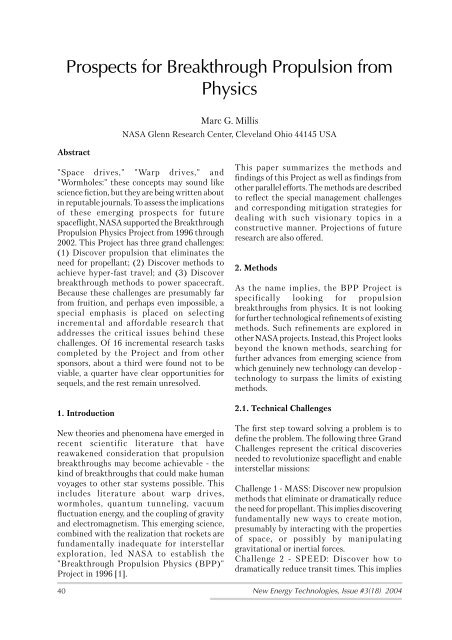Issue 17 - Free-Energy Devices
Issue 17 - Free-Energy Devices
Issue 17 - Free-Energy Devices
You also want an ePaper? Increase the reach of your titles
YUMPU automatically turns print PDFs into web optimized ePapers that Google loves.
Prospects for Breakthrough Propulsion from<br />
Physics<br />
Abstract<br />
"Space drives," "Warp drives," and<br />
"Wormholes:" these concepts may sound like<br />
science fiction, but they are being written about<br />
in reputable journals. To assess the implications<br />
of these emerging prospects for future<br />
spaceflight, NASA supported the Breakthrough<br />
Propulsion Physics Project from 1996 through<br />
2002. This Project has three grand challenges:<br />
(1) Discover propulsion that eliminates the<br />
need for propellant; (2) Discover methods to<br />
achieve hyper-fast travel; and (3) Discover<br />
breakthrough methods to power spacecraft.<br />
Because these challenges are presumably far<br />
from fruition, and perhaps even impossible, a<br />
special emphasis is placed on selecting<br />
incremental and affordable research that<br />
addresses the critical issues behind these<br />
challenges. Of 16 incremental research tasks<br />
completed by the Project and from other<br />
sponsors, about a third were found not to be<br />
viable, a quarter have clear opportunities for<br />
sequels, and the rest remain unresolved.<br />
1. Introduction<br />
Marc G. Millis<br />
NASA Glenn Research Center, Cleveland Ohio 44145 USA<br />
New theories and phenomena have emerged in<br />
recent scientific literature that have<br />
reawakened consideration that propulsion<br />
breakthroughs may become achievable - the<br />
kind of breakthroughs that could make human<br />
voyages to other star systems possible. This<br />
includes literature about warp drives,<br />
wormholes, quantum tunneling, vacuum<br />
fluctuation energy, and the coupling of gravity<br />
and electromagnetism. This emerging science,<br />
combined with the realization that rockets are<br />
fundamentally inadequate for interstellar<br />
exploration, led NASA to establish the<br />
"Breakthrough Propulsion Physics (BPP)"<br />
Project in 1996 [1].<br />
This paper summarizes the methods and<br />
findings of this Project as well as findings from<br />
other parallel efforts. The methods are described<br />
to reflect the special management challenges<br />
and corresponding mitigation strategies for<br />
dealing with such visionary topics in a<br />
constructive manner. Projections of future<br />
research are also offered.<br />
2. Methods<br />
As the name implies, the BPP Project is<br />
specifically looking for propulsion<br />
breakthroughs from physics. It is not looking<br />
for further technological refinements of existing<br />
methods. Such refinements are explored in<br />
other NASA projects. Instead, this Project looks<br />
beyond the known methods, searching for<br />
further advances from emerging science from<br />
which genuinely new technology can develop -<br />
technology to surpass the limits of existing<br />
methods.<br />
2.1. Technical Challenges<br />
The first step toward solving a problem is to<br />
define the problem. The following three Grand<br />
Challenges represent the critical discoveries<br />
needed to revolutionize spaceflight and enable<br />
interstellar missions:<br />
Challenge 1 - MASS: Discover new propulsion<br />
methods that eliminate or dramatically reduce<br />
the need for propellant. This implies discovering<br />
fundamentally new ways to create motion,<br />
presumably by interacting with the properties<br />
of space, or possibly by manipulating<br />
gravitational or inertial forces.<br />
Challenge 2 - SPEED: Discover how to<br />
dramatically reduce transit times. This implies<br />
40 New <strong>Energy</strong> Technologies, <strong>Issue</strong> #3(18) 2004
















